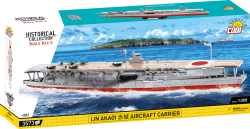Kit of the famous German battleship Tirpitz in 1:300 scale. The assembled model has rotatable gun turrets with adjustable gun aiming, removable deck cover under which the engines are stored and rotatable propellers. The Ececutive Edition series also includes a model of a deck reconnaissance aircraft and a figure of a German radio operator with a secret Enigma encryption device. Store the assembled model safely in the included display stand with description.
Show more
80 %
(2 Ranking)
| List Number: | COBI-4838 |
| EAN: | 5902251048389 |
| Warranty: | 24 months |
| Manufacturer: | COBI |
| Loyalty Points: | 29 |
| Price excluding VAT: | 3 433,61 Kč |
Description
Parametres
Files and Links2
Discussion
Reviews

You know that:
- The Bismack-class ship was officially launched on 1 April 1939 in the presence of the granddaughter of Admiral Tirpitz after whom she is named.
- At the time, she was the largest battleship in the world, and her supremacy lasted until the arrival of the Japanese ships Yamato and Musashi.
- From the first days after construction began, the British Admiralty viewed the existence of a ship of such size as an extreme danger.
- At first, the British had little information about the actual size, as official German sources gave a planned displacement of 35,000 tons in 1935, so as not to violate the German-British treaty of the end of World War I. The actual displacement, however, was 52,600 tons.
- When it became clear to the Allies what kind of machine was being built in the Kriegsmarinewerfl shipyard, they tried to destroy the ship with numerous raids before it was completed. The ship was not damaged by the raids, but there was a slowdown in the work.
- As the pride of the German Navy, Tirpitz was to be equipped with the best that the industry of the time had to offer. Search radars, artillery rangefinders, gunnery radars or, for passive protection, a durable armour made of special Wotan chrome-nickel steel were installed.
- In June 1941, Tirpitz was deployed in the Baltic Sea to block battleships and supply convoys leaving Leningrad. After the loss of the Bismarck, the ship was "scuttled" to safety at the request of Hitler himself in Norway, so that the possible loss of the Tirpitz on the Atlantic battlefields would not further deteriorate the morale of German sailors who had not yet come to terms with the sinking of the Bismarck.
- The ship arrived in Norway in January 1942, where she was anchored in a well-guarded fjord. The life of the crew was very monotonous and due to the constant lack of fuel it was not even possible to continue training.
- The British were able to decipher the messages from the Enigma machine and soon knew the exact location of Tirpitz. From this point on, the British Air Force undertook 12 operations to eliminate the battleship. It was not until an operation called Operation Catechism that they were successful.
- Bomber aircraft approached the German ship on 12 November 1944 at 9:35 a.m. A squadron of 32 Lancasters dropped 29 Tallboy bombs on Tirpitz, scoring two direct hits. A hit amidships caused the ship to flood and list. At 9:58 hrs the C gun turret exploded and was blown off, and the turret and all its machinery flew 25 m above the heads of the sailors leaving the ship. Tirpitz capsized and struck the bottom.
- In 1948 the wreck was scrapped and removed.
Technical parameters:
- dimensions: length 251 m, width 36 m, draught 8.7 m
- displacement 52 600 tonnes max.
- power unit 12x Wagner high pressure boiler with power transfer to 3 Brown-Boveri turbines with a total output of 121 MW
- maximum speed 30.8 knots
- range 16 400 km
- armour: hull 320 mm, main deck 120 mm, gun turrets 380 mm
- armament 8x 380 mm cannon + 12x 150 mm + 16x 105 mm + 16x 37 mm and 20x 20 mm cannon + 8 torpedo tubes of 533 mm calibre
- reconnaissance aircraft 4x Arado Ar 196 on two catapults
Winston Churchill about the battleship Tirpitz:
We now know about Tirpitz's presence in Trondheim. The destruction or just crippling of this ship would be the greatest current event at sea. No target can compare with Tirpitz. It is now without the air defence it would have had at Brest and which its home port would have provided. Just cripple her and she will not return to Germany. (...) The world naval situation would then change and we would regain our superiority in the Pacific'.
Assembly instructions
| Number of figurines | 1 pcs |
|---|---|
| Recommended age | 10+ |
| Scale | 1:300 |
| Number of pieces | 2960 pcs |
| Dimensions after assembly | 87 x 12 x 18 cm |
| Contains luminous blocks | No |
| Material | Plastic |
| Collection | World War II |
| Compatible with other brand of kits | Yes |
Discussion is empty.
There is no review for product yet






























































































